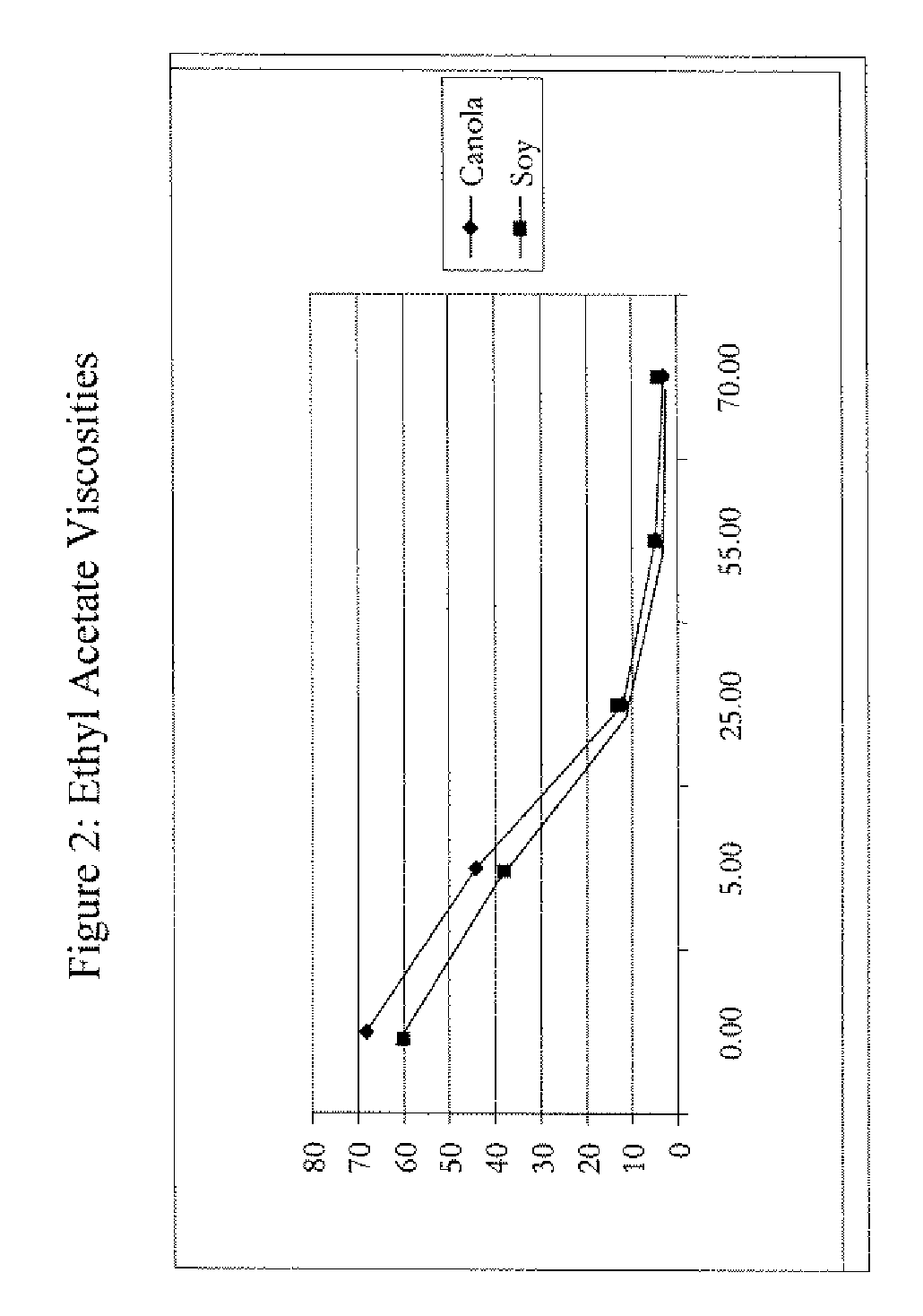Controlled viscosity oil composition and method of making
a viscosity oil and composition technology, applied in the direction of group 5/15 element organic compounds, food preparation, fuels, etc., can solve the problems of difficult to obtain an adequate high smoke point in a product, difficulty in achieving a suitable smoke point, and undesirable grain alcohol such as ethanol in such products, so as to achieve low viscosity, reduce polymerization in the engine cylinder, and achieve the effect of low viscosity
- Summary
- Abstract
- Description
- Claims
- Application Information
AI Technical Summary
Benefits of technology
Problems solved by technology
Method used
Image
Examples
example 1
[0029]An oil composition was prepared comprising 82.00% canola, 12.00% triacetin, and 6.00% lecithin. The ingredients were mixed together at room temperature until dispersion was obtained. The composition had a viscosity of 50 cp. It is noted that experimental samples also were prepared using 62% canola and 72% canola, but these samples separated into layers after a few hours and therefore were not evaluated further.
[0030]The sample with 82% canola was decanted and dispensed into a pump spray bottle. The spray pattern was evaluated by spraying the oil on a vertical board positioned 8-10 inches from the spray nozzle. The pump spray bottle dispensability was 0.793 g / spray. A spray pattern is considered to be optimum if there is a solid film of spray at least 3.5 inches in diameter. Duplicate trials were run, as set forth in Table 1 below. The spray patterns had an elongated shape with a width of less than three inches, somewhat less than optimum. The spray pattern was more concentrate...
example 2
[0033]A series of samples was prepared of triacetin blended with canola oil, and another series of samples was prepared with triacetin blended with soybean oil. In each series the percentage triacetin ranged from 0-70%. The viscosity of each sample was measured using the Brookefield viscometer procedure described above. The results are summarized in Table 2 below, and illustrated in FIG. 1.
[0034]
TABLE 2Viscosity data for blends of triacetin with canola and soyCanola & SoyViscosityTriacetin QuantitiesOil QuantitiesCanolaSoyPercentagesGramsPercentagesGramsblendblend00100.00350.0 g68 cps63 cps1.003.5g99.00346.5 g61 cps56 cps5.0017.5g95.00332.5 g63 cps53 cps10.0035g90.00 315 g60 cps54 cps15.0052.5g85.00297.5 g63 cps58 cps20.0070g80.00 280 g72 cps63 cps25.0087.5g75.00262.5 g75 cps70 cps30.00105g70.00 245 g79 cps75 cps35.00122.5g65.00227.5 g89 cps80 cps40.00140g60.00 210 g93 cps93 cps45.00157.5g55.00192.5 g104 cps 108 cps 50.00175g50.00 175 g120 cps 119 cps 55.00192.5g45.00157.5 g130...
example 3
[0036]Each of the triacetin blends identified in Example 2 was further blended with lecithin at levels of 4%, 6% and 8%, and the viscosities of each of these samples was measured by the same procedure as in the previous examples. The results are set forth in Tables 3 and 4 below.
[0037]
TABLE 3Viscosity data for blends of triacetin / Soy / lecithinTriacetinSoy0% LecithinTriacetinSoy4% Lecithin01005609657199560.9695.0461595534.891.2611090549.686.45815855814.481.66420806319.276.86925757024727430707528.867.28335658033.862.49040609338.457.699455510843.252.812050501194848132554513152.843.212460408857.638.423065357062.433.635070305867.228.852TriacetinSoy6% LecithinTriacetinSoy8% Lecithin09459092600.9493.06630.9291.08654.789.3634.687.4659.484.6629.282.86514.179.96613.878.27018.875.27318.473.67723.570.58023698628.265.89227.664.410032.961.19732.259.810637.656.411636.855.212442.351.713141.450.61434747144464615651.742.316450.641.417656.437.631455.236.840961.132.937459.832.239465.828.26664.427.668
[00...
PUM
| Property | Measurement | Unit |
|---|---|---|
| viscosity | aaaaa | aaaaa |
| diameter | aaaaa | aaaaa |
| width | aaaaa | aaaaa |
Abstract
Description
Claims
Application Information
 Login to View More
Login to View More - R&D
- Intellectual Property
- Life Sciences
- Materials
- Tech Scout
- Unparalleled Data Quality
- Higher Quality Content
- 60% Fewer Hallucinations
Browse by: Latest US Patents, China's latest patents, Technical Efficacy Thesaurus, Application Domain, Technology Topic, Popular Technical Reports.
© 2025 PatSnap. All rights reserved.Legal|Privacy policy|Modern Slavery Act Transparency Statement|Sitemap|About US| Contact US: help@patsnap.com



